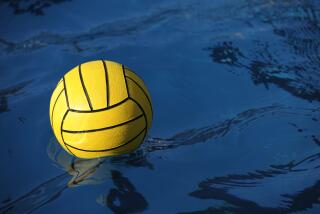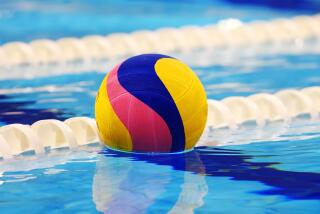Games People Play : Players Take the Plunge for Underwater Competition
- Share via
“Jaws” in your swimming pool? At least something that looks like feeding frenzies, or grown adults being taken over by some underwater cult?
No, it’s just underwater hockey, a game in which the two most important parts in your body are your lungs. Where he laughs last whose lungs last longest. Where you’re playing in three dimensions and almost zero gravity, and if you don’t get to the puck on the pool bottom in 20 seconds, forget it.
In underwater hockey, there’s only one way to go--up, for another gulp of oxygen. It’s the only sport around in which you’re not allowed to breathe. Its nearest equivalent is playing tennis on Mt. Everest. Without oxygen.
Actually, underwater hockey isn’t exactly bursting onto the scene in California; as a spectator sport, it makes Pooh Sticks look like a Super Bowl. How can an honest supporter tell what’s going on on the field when the field is 10 feet under? It must be the only sport where the only time you see the players is when they’re off the field.
Still, the game has its followers, men and women who get their kicks at the bottom of an 8- to 12-foot-deep pool, trying to get a puck into goal trays that look like giant scoops at each end. Watching from the top, all one can see is this swirl of fins and legs, then a sudden whoosh as half a dozen mouths break surface to get air.
The only fully established club in the Southland is the San Diego Underwater Hockey Club--which is really Mark Nakamura, a 31-year-old mechanical engineer; a dozen of his friends, and a trunk full of fins, masks, snorkels, “sticks” that look like short, muggers’ clubs and, most important, oven gloves. (They save knuckles on the pool floor.)
Control of the Puck
“It’s just like ice hockey without the head bashing,” Nakamura says, “maintaining control of the puck, passing, shooting and guarding the goal. The only difference is, you have to have teamwork, because you can’t hit the puck more than 10 feet, not down there, and no one person can carry on forever. That’s the secret. Having people coming down in sequence, ready to take over the puck.”
Every Tuesday and Thursday between 8 and 9 p.m., the players meet at the Mission Beach Plunge, divide into two teams of about six a side, toss the brass puck onto the bottom at the halfway point and prepare for 60 minutes of breathless excitement.
A player dives into a tangled mass of arms, legs, gaping eyes behind masks and fins flapping in his or her face. Then suddenly eardrums hurt, lungs seem about to burst and nowhere to be seen is that stupid little brass disc that’s supposed to be worth exploding for.
One of these players is Paul Ulbrich, an emergency-room doctor, who is national director for underwater hockey for the Underwater Society of America, headquartered in Daly City, Calif. Another is Marc Wasser, a 37-year-old car salesman, who suggests there’s a health benefit to the game. He credits the game with bringing his heart rate down from 75 beats a minute to 50.
Doug Bodenstab, who with a friend brought the concept from Chicago to Southern California, says it is a great release from the pressures of his job in electronic sales, even though it’s as intense a game as you could encounter. You release aggression, but everything is cushioned by water so no one gets hurt. Nobody worries about the score too much. It’s the exercise that counts.
Players say the game was invented in the ‘50s by an Englishman who called it “Octopush.” Slowly, the game spread westward. Today, the trouble is getting people to take the game seriously.
“All my friends think I’m weird,” says Erik Nelson, the youngest in the club at 16. But the game is gaining in popularity; in June, 200 players descended on San Diego for the Underwater Hockey National Championships, a lead-up to an international tournament to be held in 1990 in Europe. Nakamura’s team came in seventh of the nine teams.
“We’re not a very good team as far as the rest of the country goes,” Nakamura says. “Our trouble is we don’t have any teams to practice against.”
Anyone is eligible to play on Tuesday and Thursday nights, according to Jon Haratyk, membership representatives supervisor. The cost for members of Mission Beach Plunge is $2; $3 for non-members. It’s recommended that players bring their own masks, fins and snorkels. The Plunge is at 3115 Oceanfront Walk, Mission Beach, San Diego. Information: (619) 488-3110 or Nakamura at (619) 453-2429.
More to Read
Go beyond the scoreboard
Get the latest on L.A.'s teams in the daily Sports Report newsletter.
You may occasionally receive promotional content from the Los Angeles Times.






